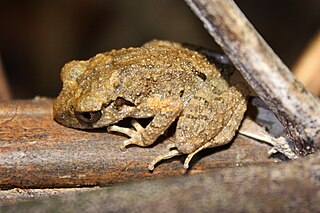
Leptobrachella is a genus of frogs in the family Megophryidae. Members of Leptobrachella are found throughout Asia including on Borneo and the Natuna Islands. They are sometimes referred to as Borneo frogs, slender-armed frogs, or dwarf litter frogs. The genus contains over 80 species with 25 found in China alone.

Pelophryne guentheri is a species of toad in the family Bufonidae. It is endemic to Borneo and only known from the lowlands of Sarawak, Malaysia, though it is likely to occur also in Sabah (Malaysia) and northeastern Kalimantan (Indonesia). Its natural habitats are tropical moist lowland forests and intermittent freshwater marshes. It is threatened by habitat loss.
Leptobrachella brevicrus is a species of amphibian in the family Megophryidae. It is only known from its type locality in Gunung Mulu National Park, Sarawak, Malaysia. Its natural habitat are stream sides in tropical moist montane forests.
Leptobrachella mjobergi is a species of frogs in the family Megophryidae. It is endemic to Borneo where it is found in Kalimantan (Indonesia), Brunei, and Sarawak (Malaysia).
Leptobrachella natunae is a species of amphibian in the family Megophryidae. It is endemic to Natuna Besar in the Natuna Islands (Indonesia) of South China Sea. It has not been recorded after its description, more than a century ago. Its natural habitats are tropical moist lowland forests and rivers.
Leptobrachella palmata is a species of frog in the family Megophryidae. It is endemic to Borneo, and only known from its type locality in Lipaso Forest Reserve, Sabah, Malaysia. Common names palm Borneo frog and palm dwarf litter frog have been coined for it.
Leptobrachella parva is a species of amphibians in the family Megophryidae. It is endemic to Borneo and found in Sarawak and Sabah, Malaysia. Its natural habitats are tropical moist lowland forests and rivers. It is locally abundant but threatened by habitat loss.
Leptobrachella alpina is a frog species in the family Megophryidae. It is endemic to Jingdong County in Yunnan, China, where it occurs in Wuliangshan National Nature Reserve; there is also a questionable record from Tianling in Guangxi.

Leptobrachella arayai is a species of frog in the family Megophryidae. It is endemic to Sabah, Malaysia. In addition to its type locality, Mount Kinabalu, it is known from Mount Trusmadi, Crocker Range, and Mendolog. Its natural habitats are tropical moist lowland forests, moist montane forests, and rivers. It is threatened by habitat loss.
Leptobrachella kajangensis, also known as the Kajang slender litter frog, is a species of amphibian in the family Megophryidae. It is endemic to Malaysia and only known from its type locality, a small cave near the top of Gunung Kajang, on Tioman Island, a small island located 32 km off the east coast of Peninsular Malaysia.

Leptobrachella liui, also known as Fujian Asian toad or Fujian metacarpal-tubercled toad, is a frog species in the family Megophryidae. Originally described from Chong'an in Fujian, it is now known to be widely distributed in southern and southeastern China from Zhejiang and Fujian west to Guizhou and Guangxi.
Leptobrachella picta is a species of frog in the family Megophryidae. It is found in northern Borneo: Crocker Range, Sabah and eastern Sarawak Malaysia as well as adjacent north-eastern Kalimantan, Indonesia. Its type locality is Mount Kinabalu. Its natural habitats are tropical moist lowland forests, moist montane forests, and rivers. It is threatened by habitat loss.

Leptobrachella tuberosa, also known as the granular toad, is a species of frog in the family Megophryidae. As currently known, it is endemic to the Central Highlands of Vietnam in Gia Lai, Quảng Nam, and Thừa Thiên–Huế Provinces. Its true range is probably wider as suitable habitat extends further north and east, reaching northeastern Cambodia and southeastern Laos. The specific name tuberosa is derived from the Latin tuberosus, meaning "full of protuberances".
Pelobatrachus edwardinae is a species of frog in the family Megophryidae. It is commonly known as the rough horned frog, Edwardina's horned frog, and Edwardina's spadefoot toad. It is endemic to northern Borneo and known from the Sabah and Sarawak provinces of Malaysia as well as from Brunei. Its natural habitats are tropical moist lowland forests and rivers. It is threatened by habitat loss.
Leptobrachella baluensis is a species of amphibian in the family Megophryidae. It is endemic to montane northern Borneo in Sabah and Sarawak (Malaysia) and northern Kalimantan (Indonesia). It has been in synonymy with Leptobrachella mjobergi, but is now treated as a valid species.
Leptobrachella aerea is a species of frogs in the family Megophryidae. It is known from Vilabouli District, Savannakhet Province, Laos and from Hà Tĩnh, Nghệ An, Thanh Hóa, and Quảng Bình Provinces of Vietnam.

Leptobrachella minima is a species of frog in the family Megophryidae. It occurs in northern Thailand, northern Laos, and northern–central Vietnam.
Leptobrachella platycephala is a species of frogs in the family Megophryidae. It is endemic to Peninsular Malaysia and only known from its type locality, Mount Benum in Pahang.
Leptobrachella bondangensis is a species of frog in the family Megophryidae. It is endemic to Central Kalimantan, in the Indonesian part of Borneo, and is only known from its eponymous type locality, Mount Bondang in the Murung Raya Regency. Common name Bondang dwarf litter frog has been coined for this species.
Lipaso Forest Reserve is a protected forest reserve in Telupid District of Sandakan Division, Sabah, Malaysia. It was designated as a Class 1 Protection Forest by the Sabah Forestry Department in 1984. Its area is 3,606 hectares (36.06 km2). The reserve is mountainous with some palm oil plantations and farms in the surroundings. The forest is mostly mixed dipterocarp. Threats to the reserve forests include fires and encroachment for agriculture.






